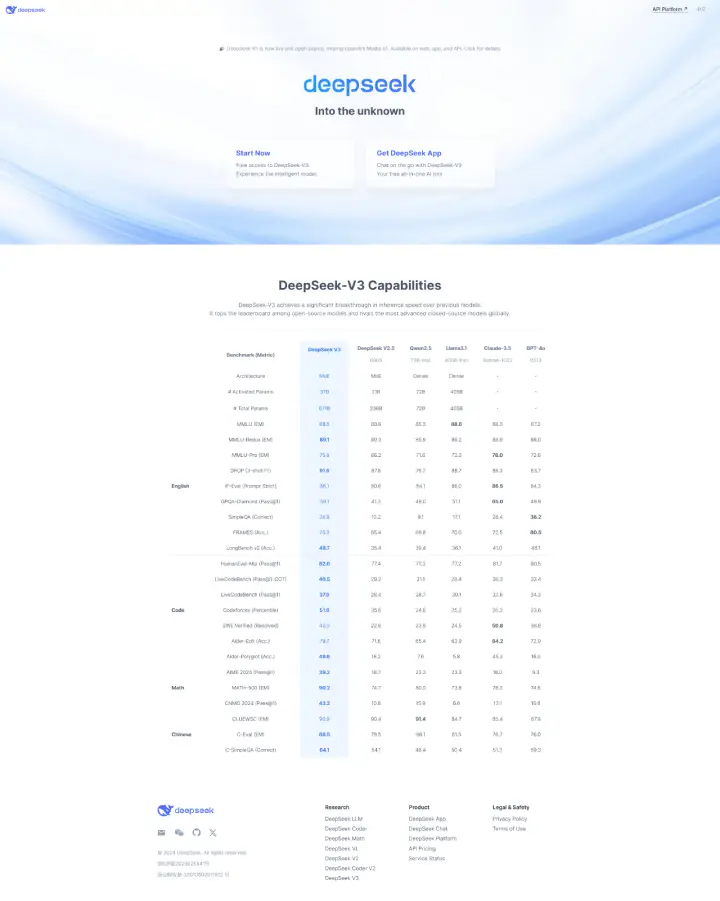The AI landscape has a new titan: DeepSeek-R1, a groundbreaking open-source model that rivals OpenAI’s proprietary systems in reasoning, coding, and mathematical prowess—but at a fraction of the cost. Released on January 20, 2025, this model has already sent shockwaves through Silicon Valley, with Meta’s CEO Mark Zuckerberg hailing it as a triumph for open-source AI. In this deep dive, we explore why DeepSeek-R1 is redefining the future of AI and how you can leverage its capabilities today.
Key Features: Why DeepSeek-R1 Stands Out
- Performance on Par with OpenAI-o1
DeepSeek-R1 matches OpenAI’s flagship model, o1-1217, in critical benchmarks:
- MATH-500: 97.3% accuracy (vs. OpenAI-o1’s 96.4%) .
- Codeforces: Achieves a 2,029 Elo rating, surpassing 96.3% of human competitors.
- AIME 2024: 79.8% pass@1 score, slightly outperforming OpenAI-o1
Its Mixture of Experts (MoE) architecture activates only 37B parameters per query, balancing efficiency with performance.
- Unmatched Cost Efficiency
DeepSeek-R1’s API costs $0.55 per million input tokens and $2.19 per million output tokens—27x cheaper than OpenAI-o1. For startups and researchers, this democratizes access to cutting-edge AI without compromising quality. - Fully Open-Source & MIT Licensed
Unlike OpenAI’s closed ecosystem, DeepSeek-R1’s model weights, training pipelines, and distilled variants (1.5B to 70B parameters) are open for commercial use, modification, and distillation. This transparency accelerates innovation, empowering developers to build specialized applications—from coding assistants to scientific analyzers. - Reinforcement Learning (RL) Breakthrough
The model’s pure-RL training framework (GRPO algorithm) eliminates dependency on labeled data. By rewarding logical coherence and step-by-step reasoning, DeepSeek-R1-Zero—the precursor—achieved self-verification and reflection capabilities. Subsequent multi-stage training with synthetic data and supervised fine-tuning resolved readability issues, resulting in the polished DeepSeek-R1.

Technical Deep Dive: How DeepSeek-R1 Was Built
Training Pipeline
- Stage 1: Cold-start fine-tuning with minimal CoT data to establish foundational reasoning.
- Stage 2: Large-scale RL using GRPO, focusing on accuracy and format rewards.
- Stage 3: Rejection sampling to generate high-quality synthetic data.
- Stage 4: Final RL across diverse scenarios to ensure generalization.
Distillation for Accessibility
Six distilled models—including Qwen-32B and Llama-70B—deliver desktop-grade performance. For example, the 14B variant outperforms QwQ-32B-Preview in coding tasks, making it ideal for local deployment.
128K Context Window
With a 128K token context, DeepSeek-R1 excels in long-form reasoning, though some users note limitations in programming tasks requiring extended prompts.
Real-World Applications
- Enterprise AI Solutions
Replace costly closed-source models (e.g., Claude Sonnet) with DeepSeek-R1 for code generation, data analysis, and customer support—all while avoiding rate limits and proprietary constraints. - Education & Research
The model’s self-fact-checking and transparency make it ideal for academic research. For instance, it can deconstruct complex physics problems step-by-step, reducing hallucinations. - Startup Innovation
Build affordable SaaS tools using Fireworks AI’s optimized endpoints ($8 per million tokens) or deploy distilled models on consumer hardware.
Challenges and Limitations
- Speed vs. Depth: While slower than OpenAI-o1, DeepSeek-R1 prioritizes accuracy over real-time responses .
- Limited Customization: The API lacks parameters like
temperatureandtop_p, restricting fine-tuning for creative tasks. - Adoption Hurdles: Analysts like Wedbush’s Daniel Ives argue enterprises may still prefer established players like OpenAI for ecosystem support.
Conclusion: The Future of AI is Open
DeepSeek-R1 isn’t just a model—it’s a movement. By proving that open-source AI can rival proprietary giants, it challenges the status quo and invites global collaboration. As Meta races to launch Llama 4 and OpenAI tightens its grip on secrecy, DeepSeek’s transparency and affordability position it as a catalyst for democratized AI innovation.
Ready to experiment?
- Try the API: Visit chat.deepseek.com and enable “DeepThink” mode.
- Deploy distilled models: Use vLLM or SGLang for local setups.
- Join the community: Contribute to GitHub repositories or explore Fireworks AI’s hosted solutions.
The AI revolution is no longer confined to Silicon Valley boardrooms. With DeepSeek-R1, it’s in your hands.
For further reading, explore DeepSeek’s technical report here .
Also Read: Top AI Side Hustles 2025: How to Make Money from Home with Artificial Intelligence